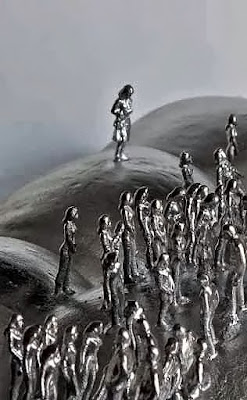Katayoun Rouhi - Kambiz Sabri exhibition at the Taiss Gallery in Paris
Curator Mrs Farnaz Bahmanyar from the 11th of March to the 7th of May 2011
A woman and a man, both born in Iran in the sixties, exhibit their paintings and sculptures at the Taiss Gallery. Their childhoods were marked by the fall of the Shah's monarchy in 1979 and the Ayatollah Khomeini's establishment of the Islamic republic a troubled time when a conservative regime replaced that of a dictator. Katayoun Rouhi left her native land at 17 to study at the Ecole des Beaux Arts of Paris, following in the footsteps of the grand masters. Her series of Trees shown at the gallery was a great success at the last auction at Sotheby's in Doha last December. Her book, "L'ontologie du lieu (The Ontology of the Place)", an interrogation on the act of creation, has just been published by Editions L'Harmattan. Kambiz Sabri chose to remain in Tehran where he acts as a sculptor, designer and professor. He participates in numerous biennial exhibitions and coordinated the Iranian pavillion at the 51st Venice Biennial.
The Taiss Gallery welcomes these two artists for a confrontation between their works. At first glance, they would seem to have little in common. However, a more penetrating look reveals symbols that reveal a similar quest: that of knowledge. Kambiz Sabri regards the world with detachment, the better to know and understand it. The movements of the sculpted mattresses that welcome groups or solitary individuals symbolize the valleys that man, according to the philosopher Sufi, must cross to gain truth and thus discover his deepest self. Katayoun Rouhi's paintings represent this quest for self that passes through introspection and the necessity of living in osmosis with nature. Both speak in a symbolic manner. Both have the same objective, plenitude.
Katayoun Rouhi's paintings show a young girl before a tree or advancing down an alley in the direction of a faraway light. A Persian poem composed by the artist covers the figures. Written backwards, it cannot be read. The meaning is hidden behind the sign as if to signify the importance of the underlying words, of the allegory." During the repression, poetry allowed one to say a lot of things," says the artist. The figure of the child, a melange of the artist's daughter and herself as a child, is shown from the back, allowing one to identify oneself with her. In this way she becomes a generic, timeless figure. The tree itself also symbolizes the quest for identity. Is it the Tree of Life, the Tree of Knowledge, a Family Tree, the Cosmic Tree?" Everyone can see what they wish. But in Persian poetry, it is a point of reference. During my childhood we oriented ourselves in the wild by the trees that punctuated the landscape." The classical style of her paintings confronts a surrealistic representation. The artist paints her unconscious. And in the image of Persian calligraphy, perspective has disappeared. The nature, the writing, the human, the monochromatic background, the white line and the young girl are treated on the same scale, as if to represent the sought-after unity. By repeating the same poem for four years, by drawing these same figures for four years, the artist accentuates the spiritual dimension of this series by the spell-binding aspect in the form and in the idea.
Before the paintings of Katayoun Rouhi which invite introspection, Kambiz Sabri's sculptures open themselves to the world. Dozens of individuals stand upon a disproportionately large mattress. Some in groups, some alone, they all seem similar. But the closer one looks, the more differences reveal themselves. In this uniform group, attitudes are distinguished. The majority of them are immobilized in anticipation of an action that never comes. Others advance to act. These works are understood as metaphors for today's world. They play on contradictions. They invite a back-and-forth from near to far, between a mass view and a close-up, between the hope for a harmonious world thwarted by the desire for domination of a Small group hidden somewhere outside of this representation. These same oppositions are found in the execution. Stylized forms confront precise representations, the symbolic faces realism. A second, more violent, more critical reading then takes form. The fragility of the soft matter turns to stone. The apparent lightness becomes judge. The tension is obvious." I dream of the day when the wars and conflicts will be replaced by luminous and joyous parties, where collective expression will become sacred." Kambiz Sabri imagines this beatitude, foiled by conflicts engaged in for domination, by this desire to slouch like a Roman emperor partaking of every luxury as he sends his army to their deaths.
"Iranian philosophy is based on the apparent and the hidden. What you see has to relate to something invisible that must be revealed," explains Katayoun Rouhi. The creations of these two artists borrow from this culture. Their remarks are hidden behind the form. It is up to each of us to lift the veil.
Aude de Bourbon Parme
Katayoun Rouhi, Ut poesis pictura, 2011, huile sur toile, 195 x 130 cm
Kambiz Sabri, sans titre, 2010, detail
Via Taiss Gallery and Peyvand






No comments:
Post a Comment